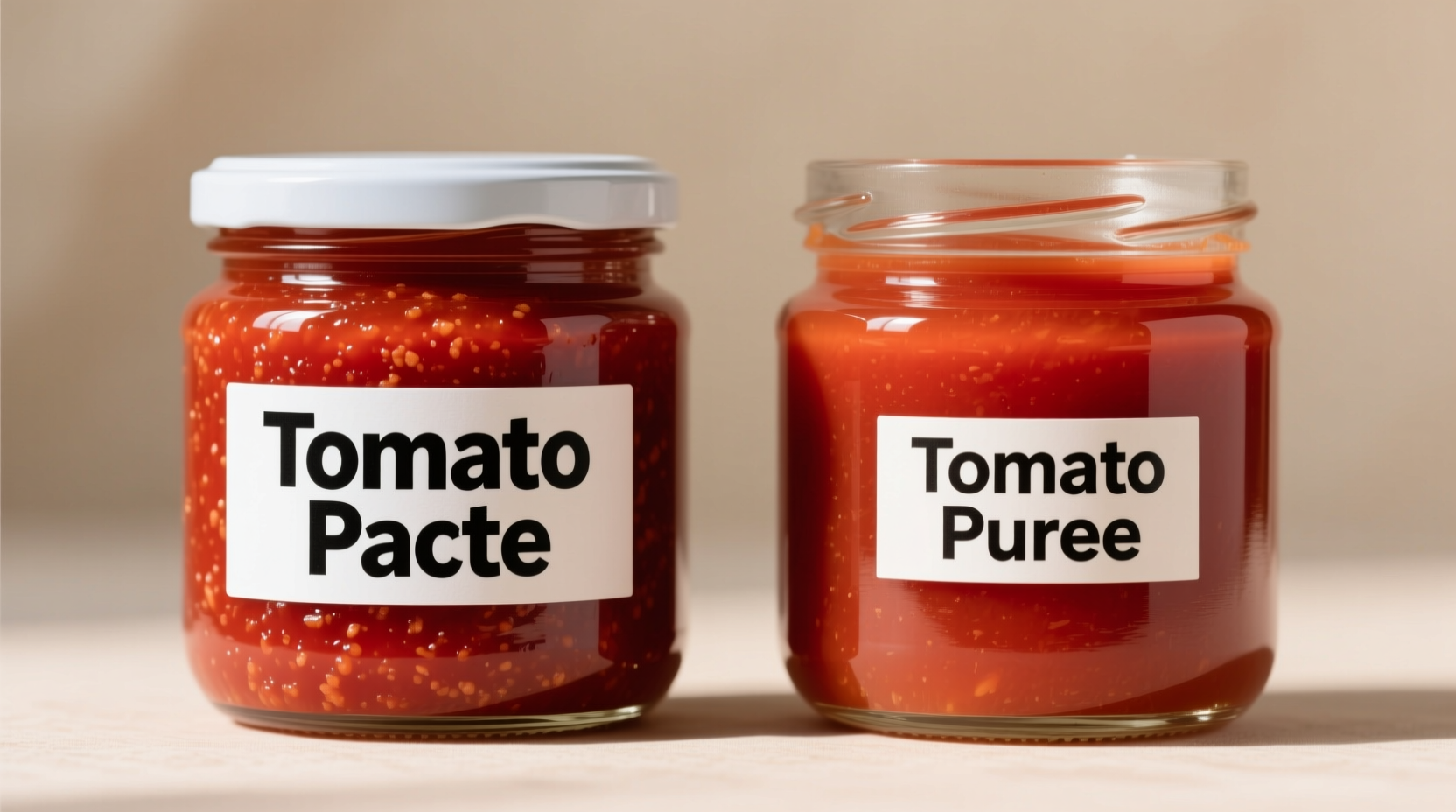Have you ever stood in the grocery aisle confused by the similar-looking tomato products? Or started a recipe only to realize you grabbed the wrong one? You're not alone. Many home cooks mistakenly treat tomato paste and puree as interchangeable, leading to sauces that are too thin or dishes that lack depth. Let's clarify exactly how these products differ and when you can (and can't) substitute one for the other.
Understanding the Fundamental Difference
The core distinction between tomato paste and puree lies in their concentration level. Both start as fresh tomatoes, but undergo different processing:
| Product | Tomato Solids | Water Content | Texture | Flavor Intensity |
|---|---|---|---|---|
| Tomato Puree | 8-12% | 88-92% | Smooth, pourable liquid | Mild tomato flavor |
| Tomato Paste | 24-30% | 70-76% | Thick, almost solid | Intense, concentrated tomato flavor |
According to the USDA's standards for canned tomato products, tomato paste must contain a minimum of 24% tomato solids, while tomato puree ranges between 8-12% solids. This concentration difference dramatically affects how each product behaves in cooking.
How They're Made: A Production Timeline
Understanding the manufacturing process reveals why these products differ so significantly:
- Harvesting: Tomatoes are picked at peak ripeness (typically July-September in North America)
- Processing: Tomatoes are washed, sorted, and heated to remove skins
- Initial Puree: Skinned tomatoes are passed through a sieve to create a basic puree
- Concentration: For paste, this puree undergoes evaporation to remove water content
- Final Product: Puree is canned as-is; paste requires additional cooking down
This concentration process for paste typically takes 2-3 hours of slow cooking under controlled conditions to achieve the proper consistency without scorching, as documented by the USDA Agricultural Marketing Service.

When Substitution Works (and When It Doesn't)
While you might be tempted to swap these products, understanding their culinary roles prevents recipe disasters. The key factor is whether your dish has sufficient cooking time to reduce liquid:
Situations Where Substitution Works
- Long-simmering sauces: In recipes that cook for 45+ minutes, you can substitute 2 tablespoons of paste for 1/2 cup puree (and adjust liquid)
- Stews and braises: The extended cooking time allows paste to hydrate properly
- When building flavor base: A small amount of paste added to puree enhances depth
Situations Where Substitution Fails
- Quick sauces: In 15-20 minute preparations, paste won't hydrate properly
- Cold preparations: In gazpacho or cold sauces, paste won't incorporate smoothly
- Pizza sauce: Puree creates the right consistency; paste makes sauce too thick
Professional chefs at the Culinary Institute of America note that improper substitution is one of the top five mistakes home cooks make with tomato-based recipes, often resulting in sauces that are either watery or overly thick.
Maximizing Flavor in Your Cooking
Understanding how to use each product properly transforms your dishes:
Tomato Puree Best Uses
- As the base for quick tomato sauces (ready in 20-30 minutes)
- In soups where you want tomato flavor without intense concentration
- For pizza sauce that spreads easily and cooks quickly
- When making cold tomato-based dishes like gazpacho
Tomato Paste Best Uses
- As a flavor foundation ("sofrito") sautéed with onions and garlic
- In long-cooked sauces, stews, and braises
- To thicken sauces without adding excess liquid
- For concentrated tomato flavor in small quantities
When using tomato paste, professional chefs recommend "blooming" it in oil for 1-2 minutes before adding other liquids. This crucial step, documented in the Food Science and Cooking journal, caramelizes the sugars and develops deeper flavor compounds that don't emerge when paste is simply added to liquid.
Storage Guidelines for Maximum Freshness
Proper storage extends the usability of both products:
- Unopened: Both keep for 12-18 months in a cool, dry pantry
- Opened tomato puree: Transfer to airtight container; refrigerate for 5-7 days
- Opened tomato paste: Portion into ice cube trays, freeze, then transfer to freezer bags (keeps 6 months)
- Signs of spoilage: Mold, off odors, or significant darkening
The National Center for Home Food Preservation confirms that freezing tomato paste in 1-2 tablespoon portions provides the best quality retention for future use.
Frequently Asked Questions
Here are answers to the most common questions about tomato paste and puree:
Can I make tomato paste from tomato puree?
Yes, but it requires significant reduction. Simmer 2 cups of puree uncovered for 45-60 minutes until reduced to about 1/2 cup. Stir frequently to prevent scorching. The USDA Complete Guide to Home Canning confirms this method produces paste with approximately 24% solids content.
Why does my sauce taste bitter when I use tomato paste?
Bitterness usually occurs when tomato paste is added directly to liquid without "blooming" it first. Professional chefs recommend cooking paste in olive oil for 1-2 minutes until it darkens slightly. This caramelizes the natural sugars and eliminates bitterness, as explained in the Culinary Institute of America's Professional Cooking textbook.
What's the difference between tomato sauce and tomato puree?
Tomato sauce contains additional ingredients like herbs, onions, and garlic, while puree is just tomatoes. According to FDA standards, tomato sauce must contain 6.5-8% tomato solids, placing it between puree and paste in concentration. Puree serves as the base for making sauce, while paste provides concentrated flavor.
Can I use tomato paste instead of puree in pizza sauce?
Not directly. For pizza sauce, you need the thinner consistency of puree. If substituting paste, use 2 tablespoons paste mixed with 1/4 cup water per 1/2 cup of puree required. The American Pizza Community's technical guidelines specify that proper pizza sauce should have 8-10% solids content for optimal spreadability and cooking behavior on pizza.











 浙公网安备
33010002000092号
浙公网安备
33010002000092号 浙B2-20120091-4
浙B2-20120091-4